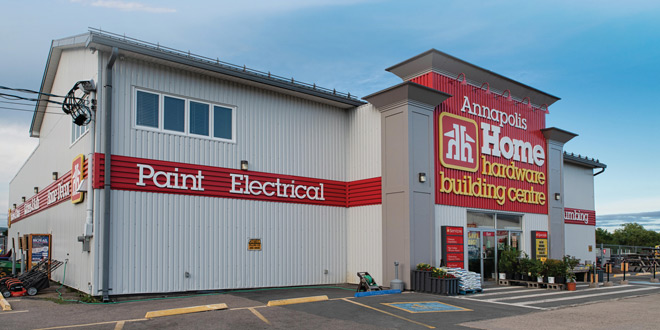Increasing sales doesn’t always require a major capital investment. You can use tools you already have, which is what Victoria Cook-Cranton, floor manager at Annapolis Home Hardware Building Centre (AHHBC), has discovered.
Cook-Cranton has spent the past couple of years on a campaign to increase the average transaction size in her 10,000-square-foot hardware and building supply store in Annapolis Royal, Nova Scotia. To help with the project, she made a small investment in point-of-sale signage and increased the budget for her circular flyer program, but instead of spending a lot of cash, she looked for ways to make her current operation more efficient.
Her efforts are quickly paying off. In one year, average sales per customer have increased by more than 7 percent. The owners of the business, who manage six locations in the southwestern part of Nova Scotia, are now beginning to implement her ideas in the rest of their operation with similar results.
Cook-Cranton focused on three areas to impact transaction size: employee training, merchandising and inventory. Here are some of the ways she made it happen and what you can learn from her efforts.
Training
One of the most effective ways to boost transaction size is to increase add-on sales. Start by offering proper training to your staff.

- Change the way employees approach customers. At AHHBC, the path to the sale begins with the way employees greet customers. “We train staff to say, ‘What project are you working on today?’ not ‘What do you need today?’ Employees should be having conversations with customers that focus around a project,” Cook-Cranton says. Talking through a project with a customer leads more naturally to talking about the different products needed to finish that project. When employees answer questions about projects, they can recommend additional products specific to what customers are working on, rather than just guessing what they need. In addition, remind employees that add-on sales are a function of customer service and they are saving customers time by eliminating return trips to pick up items they may have missed
- Train on product knowledge. To start project conversations with customers, employees need a firm grasp on product knowledge. Cook-Cranton blocks out specific times for employees to focus on training so they can have a basic understanding of core products in every department in the store. “We have always emphasized product knowledge training,” she says. “We use training resources provided by our wholesaler, vendors and the North American Retail Hardware Association. People can only sell what they know.”
- Reinforce training often. staff members for Shift Starter meetings. Often, employees will talk about training they’ve recently completed and review new products or seasonal items. Those items are usually good candidates for add-on sales. Managers also use the morning meetings to share the average sales and margins from the previous day. This helps employees understand the larger goals of the company and how every sale they make contributes to those goals.
Merchandising
Good merchandising techniques can sell impulse items all day long. Just be sure you are being smart about using those merchandising tools.

- Be strategic with clip strips. Chief among the silent sellers is the oft-forgotten clip strip. AHHBC used to have only a few clip strips scattered throughout the store. Now, there is one in nearly every 4-foot section. Cook-Cranton and her staff put as much strategic thought into each clip strip as they might an endcap.“In years past, we had been using clip strips as another way to clear out extra products,” she says. “Now, the decision of what to put on a clip strip has become more strategic. We are looking for items that are seasonal, that have good margins or relate directly to a project.”She recommends placing less expensive items on clip strips. That way, customers are more likely to visit the aisle in the store where they can see all of their options and often purchase the more expensive item.
- Change merchandising often. Keeping merchandising fresh is a weekly task at AHHBC. Displays in the center aisle are changed out at least once a month and endcaps are changed once a week. Dump bins and entryway displays are changed once a week and sometimes more often, depending on how quickly product sells.“Change is a continual process for us because 80 percent of our customers come in every week or every day,” Cook-Cranton says. “If they come into the store and start to see the same displays, they’ll become blind to them.”
- Highlight project sales. One of the recent changes Cook-Cranton made was to include more projects on endcaps. She is also focusing circular advertising around projects, rather than just stand-alone promotional items. Projects can range from the complex, such as refurbishing a deck, or simple, such as mopping a floor. “Look for those items that can be grouped together with something else, even if the project is simple,” she says. “You want customers to see the product they came in for, but also stop and think about what else they might need.”
Inventory
Don’t let your inventory hold you back. The way you manage your inventory can affect your overall transaction size.

- Count carefully and frequently. When shoppers start filling up their baskets with a project sale, it’s critical you have the quantities they need. If you don’t, they may go somewhere else for the entire purchase. Effective inventory management can help reduce out-of-stocks. Cook-Cranton uses regular cycle counts for maintaining proper quantities. Accurate inventory has become even more critical, she says, now that the store’s inventory is online. Customers may be making shopping decisions based on product availability. You build their trust if inventory shown online matches what’s in the store.
- Focus on a niche. If you invest in a niche or a new category, look for those items that will attract a large audience, even if it means stepping outside the boundaries of what you normally sell. In 2019, the owners of AHHBC decided to bring in some gift items such as holiday blankets for the Christmas season. The store had never sold those items before, but they had a huge impact on their end-of-the-year sales.
- Work with what you have. Placement is often more important than quantity. “More product doesn’t equal more sales. We address that by making sure the product we have is in the correct place, even giving it multiple homes on the floor,” Cook-Cranton says. If an item doesn’t sell well in one location, she’ll move it. Finding the optimum place where each item will sell is a continual process that requires ongoing attention.
 Hardware Retailing The Industry's Source for Insights and Information
Hardware Retailing The Industry's Source for Insights and Information







